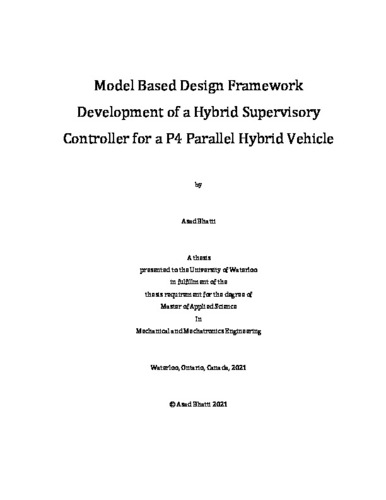| dc.contributor.author | Bhatti, Asad | |
| dc.date.accessioned | 2021-09-14 19:50:10 (GMT) | |
| dc.date.available | 2021-09-14 19:50:10 (GMT) | |
| dc.date.issued | 2021-09-14 | |
| dc.date.submitted | 2021 | |
| dc.identifier.uri | http://hdl.handle.net/10012/17384 | |
| dc.description.abstract | The expected rise in the number of ECUs in an automotive based development environment,
poses additional efficiency risk on developer time and code complexity. This thesis examines
the design and validation of a Hybrid Supervisory Controller, developed for the University of
Waterloo Alternative Fuels Team’s (UWAFT) retrofitted P4 parallel Chevrolet Blazer, in the
EcoCAR Mobility Challenge competition.
The controller, component models and I/O interaction layers are developed in a MathWorks
Simulink environment. The framework discussed, is built to incorporate automation via a
custom developed -Model-Configurator tool. Component models, and functional sub-systems are
converted to masked library blocks within Simulink, that are populated via an object-oriented
class in the MATLAB environment. This opens the possibility for custom environment data
population, swapping of data for models while retaining underlying physics and setting up for
SIL/HIL requirements testing without explicit/contemporary interaction with the Simulink
environment. The advantages of this approach are discussed, along with explanation
accompanying the software framework.
The HSC incorporates interaction models of 9 stock vehicle, and on-board GM ECUs. The
model spans full chassis longitudinal, and powertrain components. The functional controller
incorporates 4 powertrain control layers - fault detection, vehicle state control, torque strategy
and component level execution layers. The test environment switching time is reduced by
>50%, and 86 controls requirements are tested over the course of 3 years.
The test vehicle is tested at the Canadian Technical Center McLaughlin Advanced Technology
Track (CTC MATT) where a non-standard drive cycle is used due to limitations posed by the
COVID-19 pandemic. The vehicle robustly sustains a 91-minute city/highway drive, with a 24%
improvement in fuel economy compared to stock. The vehicle however is short of its VTS
targets which are attributed to the lack of engine start/stop functionality, and a thermally
constrained battery pack. Those remain major design shortcomings and immediate powertrain
improvements are proposed, and efficacy of a well-organized model are discussed. | en |
| dc.language.iso | en | en |
| dc.publisher | University of Waterloo | en |
| dc.subject | Model Based Design | en |
| dc.subject | Hybrid Supervisory Controller | en |
| dc.subject | Parallel Hybrid | en |
| dc.subject | Requirements Driven Testing Framework | en |
| dc.title | Model Based Design Framework Development of a Hybrid Supervisory Controller for a P4 Parallel Hybrid Vehicle | en |
| dc.type | Master Thesis | en |
| dc.pending | false | |
| uws-etd.degree.department | Mechanical and Mechatronics Engineering | en |
| uws-etd.degree.discipline | Mechanical Engineering | en |
| uws-etd.degree.grantor | University of Waterloo | en |
| uws-etd.degree | Master of Applied Science | en |
| uws-etd.embargo.terms | 0 | en |
| uws.contributor.advisor | Fraser, Roydon | |
| uws.contributor.affiliation1 | Faculty of Engineering | en |
| uws.published.city | Waterloo | en |
| uws.published.country | Canada | en |
| uws.published.province | Ontario | en |
| uws.typeOfResource | Text | en |
| uws.peerReviewStatus | Unreviewed | en |
| uws.scholarLevel | Graduate | en |

